December 15, 2022
Today on Microsoft Flight Simulator, I’ll be flying a famous stubby-nosed racer, the Gee Bee Super Sportster, that won speed records in the 1930s – but proved deadly to many who flew it.
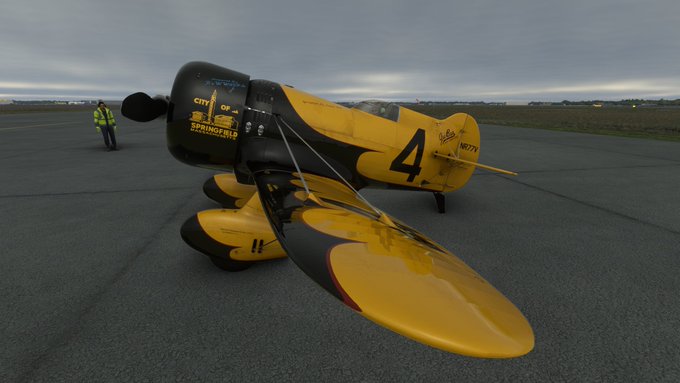
And there’s a reason I’m here under wintry, overcast skies at Detroit’s Wayne County Airport, because this is where this plane, at least (the Model Z) met its tragic end.

“Gee Bee” stands for Granville Brothers, five brothers from New England who started a fledgling aircraft company in the late 1920s.

The oldest brother, Zantford Granville, nicknamed Granny, didn’t have much of a formal education but was a natural, intuitive engineer. An auto repair shop he opened in Boston quickly blossomed into a small airplane factory.

Their first design, a biplane introduced in 1929, incorporated many cutting-edge improvements such as landing flaps, steerable brakes, a tailwheel (as opposed to just a strut) – things they had learned about from repairing other aircraft.

One early fan of the Granville Brothers’ planes was a local barnstormer and racer named Lowell Bayles. Born in southern Illinois, Bayles worked in the local coal mines to earn the money to buy his first plane. He later became an airline pilot flying Ford Trimotors in New England.

Bayles helped persuade a wealth family in Springfield, MA, the Tates, who had just opened the city’s first airport, to invest in the Granville Brothers’ company and invite them to relocate there from Boston.

But then, later in 1929, the stock market crash happened and the market for airplanes collapsed, suddenly leaving the Granville Brothers in difficult straits.

They turned to racing – and the monetary awards to be won from winning prominent air races – as a life raft.

In the 1920s, the great aviation feats – and contests involving prize money – focused on being the “first” to fly some long-distance route, like Lindbergh from New York to Paris, or Kingsford Smith across the Pacific to Australia.

By 1930, the great routes had mostly been flown, and the focus shifted to setting speed records in organized air races, either long distance or around a track marked with pylons.

The races provided a chance for airplane makers, whose market had otherwise largely dried up, to earn some much-needed cash by pushing the limits of design and performance.

The Granville Brothers established a special racing company and sold stock to local Springfield businessmen at $100 a share, and raised the $5000 needed to build the Model Z in two short months. Like “The Spirit of St. Louis”, they named the plane after the sponsoring city.

$5000 was enough because a lot of parts, like the tires, instruments, engine, and propeller were donated by corporate sponsors that wanted to get their name attached to a champion airplane.

The Model Z’s engine was 535hp radial Twin Wasp lent by a small company called Pratt & Whitney in nearby Hartford, CT. They went on to produce roughly half of the engines used by Allied planes in World War II.

To get into the cockpit, the windshield had to be unbolted and lifted off, then bolted back down again, as you can see here.

Here’s a view of the Model Z inside the cockpit. The control stick is in the center, and the power controls are on the left – as was normal for single-engine airplanes up through WW2.

I’ve got it started and taxied to the runway. It is super difficult to see over the raised nose at all, when it’s on the ground.
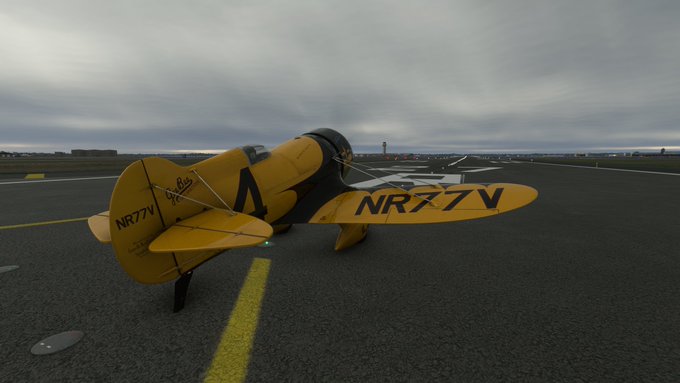
The Gee Bee was notorious for being difficult to handle on the ground. On takeoff, it suddenly wants to lunge to one side, and you have to give the rudder a good kick. But not too long, because it very easily overcompensates and lunges even harder in the opposite direction.

In August 1931, Lowell Bayles flew the Gee Bee Model Z at the National Air Races, winning several trophies and achieving a top speed of over 267 miles per hour.

But the real triumph came on September 7, when Bayles beat Jimmy Doolittle and other famous racers to win the Thompson Trophy, which emphasized low altitude flying and fast turns. The Gee Bee was suddenly famous.

I don’t know what flying it must have been like, but whenever I pushed it over 200 knots, like I’m doing here, the thing started rattling and buffeting like a bucket of bolts.

After winning the Thompson Trophy, the Granville brothers installed a new 750hp Pratt & Whitney Wasp Senior engine, for Bayles to try for the world speed record.

In his first attempt, here at Detroit’s Wayne County Airport on December 1, 1931, Bayles clocked an unofficial speed of 314 mph, well above the existing record of 278. But on the official run the difference was too small to establish a new record.

So Bayles came back on December 5 to try again. He began his run with a dive to build up speed, along this railroad track running north of the airport.

Right about here, the airplane suddenly went into a spin and drove straight into the ground, exploding and killing Bayles instantly.

The entire event was recorded on film, here:
The hangar in the film still stood in the middle of the airport’s main rental car facility until a few years ago, when it was torn down to make more parking spaces. You can see the large outline of it below to the right.

What caused the Gee Bee Model Z to suddenly crash? It’s thought that the gas cap came loose and crashed through the windshield, incapacitating Bayle. But the airplane, in any case, was highly unstable and prone to snap spins.

The Gee Bee racer had established its reputation as a killer – but it had also established its reputation for speed. So the Granville brothers and the Springfield racing team would be back.

The following year, 1932, the Granvilles improved on the design of the Model Z, producing two sister planes, the R-1 and R-2.

I’m here at Cleveland’s airport, the site of the National Air Races that year, with the R-2 (#7). The R-1 was #11.
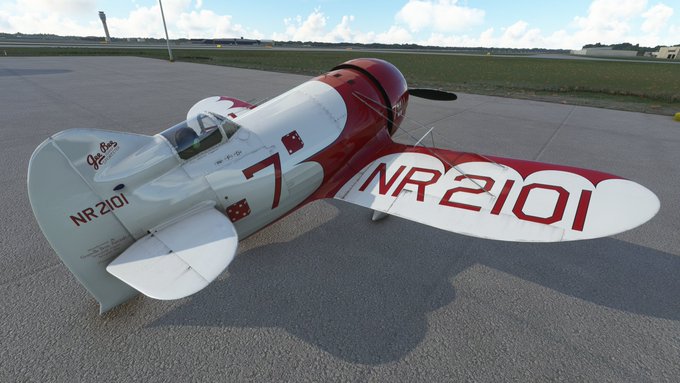
The R-1 was designed as a pylon racer and had a 730hp Pratt & Whitney Wasp engine. The R-2 had a somewhat less powerful Wasp engine, and was designed for longer-distance cross country races.
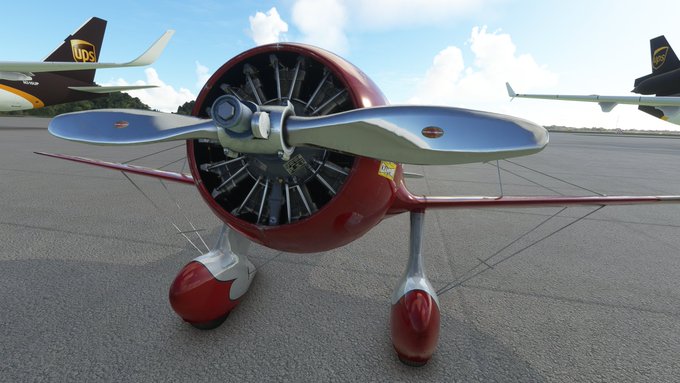
The cockpit was set even farther back on the tail than in the Model Z, giving it the appearance of a flying engine. This time, however, there was a little hatch door for the pilot to enter.

The inside of the cockpit. I believe this is modeled on a replica of the R-2 that was flown by pilot Delmar Benjamin in air shows, hence the more modern appearance.

The Granvilles had won $17,000 by taking the Thompson Trophy the previous year. They paid their shareholders a 100% dividend ($5,000) and used the rest to keep their business going.

Pilot Russell Boardman was a major financial sponsor of the R Series, on the condition that he would fly the plane in the National Air Races.

But Boardman was badly injured in a crash beforehand, so they needed to find a new pilot.

Enter Jimmy Doolittle, one of the pilots Bayle had beaten for the Thompson Trophy in 1931. Doolittle was one of the most famous aviators in the country, and played a key role in helping design many of today’s modern cockpit instruments.

Doolittle flew the Gee Bee R-1 in 1932 to win the Thompson Trophy, lapping all but one other plane in the race.

Later in the same competition, Doolittle set the new world landplane speed record of 296 mph, in the R-1.

At the time, Doolittle had nothing but praise for the Gee Bee racer that took him to victory. Later, in his memoirs, however, he said the Gee Bee was the most dangerous plane he ever flew – and this is a guy who flew a lot of planes doing dangerous stuff.

I was able to get the R-2 up to about 270mph before it started to shake and shiver all over.

The big issue was stability. Stability is the tendency of an airplane to stay or resume its current course and attitude. Helicopters are unstable. The Gee Bee was not very stable, especially in pitch (up/down) and yaw (left/right).

To some extent, this was a good thing. If an airplane it too stable, it’s not very maneuverable. But if it’s not stable enough, it takes a lot of skill not to lose control.

Coming in to check out downtown Cleveland.

Hello Cleveland!

Landing the Gee Bee is not easy. Especially on the R-2, the nose really blocks the view forward. This is the last glimpse I got of the runway before landing.
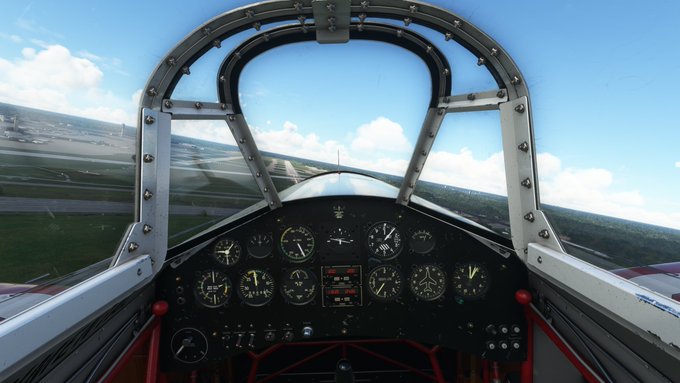
It also has a high stall speed, around 100mph, so you have to come in very fast, and it’s easy to lose lateral control. I can’t say that every landing I tried went quite as planned.

But this one worked out okay.

During the 1933 Bendix Trophy long-distance race, Boardman (who was back in the cockpit) pulled the R-1 up too soon on takeoff, stalled, crashed, and was killed – confirming the Gee Bee’s reputation as dangerous.

The next year, in 1934, the oldest Granville brother, Zantford (“Granny”) was killed in an airplane accident of his own. The company, which had never been larger than 20 employees, folded up shop.

Jimmy Doolittle, of course, went on to lead the first US bombing raid on Japan after Pearl Harbor.

The Gee Bee racer proved a vital link in the transition from biplanes to the high-powered, barrel-engined, low-wing monoplane fighters the US entered World War II with, like the F4F Wildcat.

The romance of the Gee Bee racer lived on in the 1991 movie “The Rocketeer”, in which replicas of both the Model Z and Model R appeared.



The Gee Bee Super Sportster was fast and dangerous. It killed some pilots. But in its brief life, it also broke new ground. I hope you found its story interesting.

[…] an earlier post, I chronicled an earlier attempt by the Gee Bee Model Z at this record in 1931. It clocked an unofficial speed of 315 mph, but a follow-on attempt to make […]